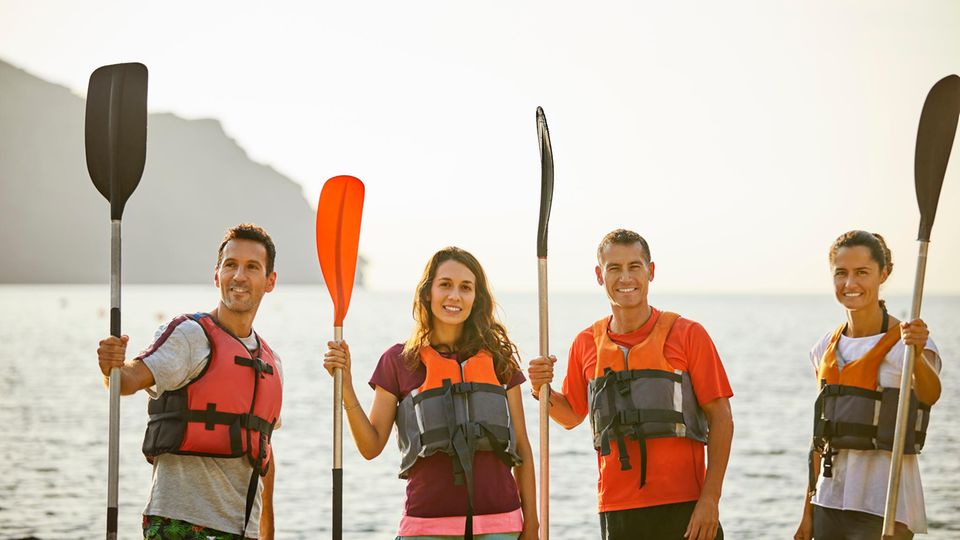There are enough rivers and lakes across Germany. They offer water sports enthusiasts the opportunity to explore the surrounding landscapes from a boat – for example with a kayak, which is equally suitable for singles and couples or families.
The kayak was originally developed by Eskimos from Greenland and was used for hunting in the open sea. This also explains the narrow and elongated shape of the body: it should make the boat faster. Nowadays the kayak – at least in European regions – is only used as a means of transport or sports equipment for leisure. Especially on sunny days you can see the agile boats in many places on the water, but less often the originals than inflatable kayaks. The advantages and disadvantages of the foldable models and what you should consider when kayaking are explained here.
Inflatable kayaks: you need to know that
Derived from the Greenlandic word “Qajaq”, a kayak is also a canoe – in other words, a boat that is moved in the direction of travel with the help of paddles. However, since the canoe is a generic term, other types of boats, such as the Canadians, are also included. In contrast to the Canadian, the kayak is not open at the top, but closed all around (except for the seat hatch). Single or double seaters are typical, but there are also larger models for . To move around in it, a double paddle is used: This is a paddle with two blades.
Inflatable kayaks are suitable for leisurely tours of discovery through the surrounding villages, but can also be used as training equipment or for fishing. The most important requirement is that you can swim – you should also always keep an eye on the maximum load capacity. This not only applies to the number of people traveling, but also to the total weight (including luggage). Most kayaks can stow the equipment on the outside: there are small nets or cords that you can use can attach.
Price vs. performance: that’s the difference
The so-called inflatable kayaks are usually made of a polyester fabric that is coated with PVC or rubber. The boats are inflated with the help of an air pump, which is already included in the scope of delivery of many providers. The air is pumped into the boat chambers provided for this purpose until enough pressure has been built up and the kayak has assumed a stable shape. In terms of price, the cheapest models are just under . There are even single-seaters for . However, due to their rather thin boat skin, these inflatable kayaks are only suitable for calm waters such as rivers and bathing lakes.
Even if you have to make a few compromises in terms of workmanship, quality and handling characteristics with the cheapest inflatable kayaks, you can go on shorter paddling tours without any problems. For longer distances, on the other hand, you should rely on higher quality models that have a higher operating pressure and more robust material. That makes them more stable – but also more expensive: here the inflatable kayaks cost between 300 and 600 euros. The two-seater costs around 800 euros, for example. In addition: the paddles and the pump must also be ordered.
The pros and cons of inflatable kayaks
Advantages of inflatable kayaks:
- They are easier to transport
- They are light in weight
- They take up less space
- They are cheaper to buy
Disadvantages of inflatable kayaks:
- They are harder to control
- They are slower than “real” kayaks
- They have less depth
- They are more prone to cross winds and head winds
Kayaking safely: the right equipment
- You need the paddle to steer and control the boat. It is usually included in the scope of delivery, but can also be purchased individually. In any case, you need a paddle with two blades – here you can switch to another model that has to be put together. This makes it easier to transport.
- For short stretches on small rivers or bathing lakes, your normal bathing clothes are perfectly adequate on warm days. If it rains, we recommend wearing waterproof clothing such as rain jackets and trousers, as moisture removes heat from the body. A is suitable for cold days and cool waters .
- A helmet is usually not necessary on calm waters, but it should be worn whenever you go whitewater in your kayak. The strong currents as well as dangerous obstacles such as rocks and branches can injure you faster if you should capsize your boat.
- Children in particular should definitely and always have one carry in case you capsize your kayak. But it is also useful for adults to carry it, for example if you are kayaking on waters with faster currents or on the open sea with waves. To be on the safe side, you should always have one with you.
Tip: This is how you get into the kayak correctly
It sounds so simple and yet getting into the kayak is not that easy – especially when the boat is already in the water. So that you can easily get into the kayak from the shore, you should hold the boat straight with one hand and one foot: first step into the kayak with one foot and balance your balance until the boat no longer wobbles. Only then does the second foot come into the kayak while you still hold onto the bank with one hand. Until they are safely seated. If, on the other hand, you want to let the inflatable kayak into the sea on the beach, you can simply sit in the boat in the shallow water and then paddle into the deep water. The paddle can be used as a support in any body of water, be it for balance or as a kind of extended arm.
David William is a talented author who has made a name for himself in the world of writing. He is a professional author who writes on a wide range of topics, from general interest to opinion news. David is currently working as a writer at 24 hours worlds where he brings his unique perspective and in-depth research to his articles, making them both informative and engaging.




